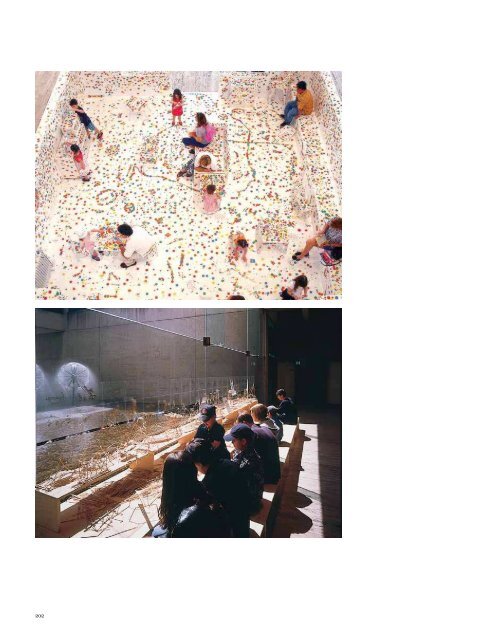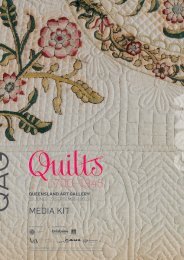Queensland Art Gallery - Queensland Government
Queensland Art Gallery - Queensland Government
Queensland Art Gallery - Queensland Government
You also want an ePaper? Increase the reach of your titles
YUMPU automatically turns print PDFs into web optimized ePapers that Google loves.
Yayoi Kusama’s The obliteration room, for Kids’ APT 2002,<br />
encouraged children to cover a white room with coloured<br />
dots / Photograph: Richard Stringer<br />
Cai Guo Qiang’s bridge building activity for Kids’ APT 1999<br />
Vibrant and ongoing relationships with leading contemporary artists have been developed<br />
through Kids’ APT. In fact, collaboration is the key component of the program. Working with<br />
<strong>Gallery</strong> staff, artists create their interactive projects — a process that enables artists to explore<br />
anew the fundamental ideas and concepts concerning them. In recognition of children’s varying<br />
interests and abilities, Kids’ APT comprises a range of media, from drawing activities to largescale<br />
multimedia projects.<br />
Internationally acclaimed artist Cai Guo Qiang, whose retrospective was held at the Guggenheim<br />
Museum in 2008, developed one of the first interactives for Kids’ APT in 1999. Designed<br />
to complement his major work in APT3, Blue dragon and bridge crossing — a large-scale<br />
installation encompassing a 30-metre-long bamboo suspension bridge constructed over the<br />
<strong>Gallery</strong>’s Watermall — Cai extended an invitation to children to design and construct a bridge<br />
using the simplest of materials: tape and cane. To provide children with inspiration, the artist<br />
sketched 76 line drawings of various bridges, revealing varied approaches, some fanciful,<br />
others basic and fundamental. Over the course of the exhibition, children visiting with parents<br />
and carers engaged with the artist’s ideas through the engineering of their own bridge models.<br />
As part of Kids’ APT in 2002, senior Japanese artist Yayoi Kusama worked with the <strong>Gallery</strong> to<br />
develop The obliteration room, referencing the obsessive repetition of dots that Kusama has<br />
incorporated into her work since the 1950s. Kusama’s space for children was fashioned in<br />
the style of a typical Australian living room, furnished with ordinary household items. Though<br />
the entire room and its contents were initially painted stark white, children ‘obliterated’ the<br />
environment by covering every surface with multicoloured dot stickers of various sizes. By<br />
the close of the exhibition five months later, the space had been transformed from a pristine<br />
interior into a spectacularly colourful and accreted environment.<br />
Contrasting with the spectacular, many Kids’ APT artist projects have also involved children<br />
engaged in quiet contemplation. Chinese artist Song Dong’s Writing with water 2002<br />
featured an installation of large rocks upon which children could write their thoughts or draw<br />
pictures with water and traditional calligraphy brushes. While evoking the revered art form of<br />
calligraphy, Writing with water also related to a performative aspect of the artist’s practice and<br />
his ongoing investigations into the passing of time.<br />
Launched in 2006 with the opening of the <strong>Gallery</strong> of Modern <strong>Art</strong>, Kids’ APT5 featured 14<br />
commissioned interactives. <strong>Art</strong>ist Khadim Ali travelled from Pakistan to his home region of<br />
Bamiyan in Afghanistan — where the Taliban destroyed the colossal ancient Buddha sculptures<br />
in 2001 — to undertake workshops with the local school children. The Bamiyan drawing project<br />
202 203
















